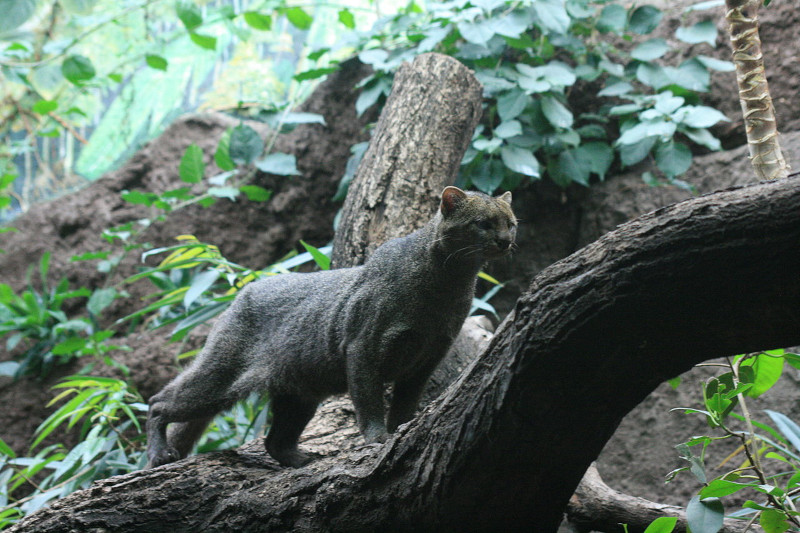Jaguarundi Facts
- The deceptively short term of Jaguarundi serves as the most frequently used common name for this visually stunning wild feline. Yet, the animal also has several other general titles by which it’s known. These options include such terms as the Eyra cat, Otter cat, and Weasel cat.
- Within the scientific community, however, it’s perhaps much better known by its purely technical designation. Unfortunately, like many such, that one’s extremely difficult for the layperson to pronounce. That’s because it holds the formal tag Herpailurus yagouaroundi.
- By either name, though, this wonder of Nature represents an animal that, sadly, now only shows scattered population groupings. Thus, it remains vulnerable for a variety of reasons. Officials generally fear that these pockets of habitation, unfortunately, seem to be dying out.
- As a result, the gorgeous creature now represents a protected species throughout the majority of its native range. Nevertheless, hunting still does not pose its greatest threat. Loss of much of its traditional habitat serves as the principal threat to the existence of this mammal.
- Additonally, the Amazon Basin currently represents the only region of its native range in which the numbers of the awesome Jaguarundi appear to be stable. Despite its somewhat uncertain situation, however, the IUCN currently lists the mesmerizing mammal as Least Concern.
- This surprising ranking appears on the organization’s published Red List of Threatened Species. Nonetheless, many people currently believe it to be severly threatened. Most likely, at the present time, its greatest threats come from habitat loss and ongoing climate change.
Related Articles
Jaguarundi Physical Description
The beautiful Jaguarundi rarely fails to capture the immediate attention and interest of those individuals fortunate enough to encounter it in the wild. However, this marvel of Nature and evolution typically does so due to its beauty alone. That’s true since it’s not a large wild feline.
This amazing product of eons of natural progression displays no noticeable degree of the physiological trait of sexual dimorphism. This extends to both appearance and physical size. Yet the wild cat does display one unique trait. This holds true due to the fact that it has a unique coloring.
That’s because the fur of different individuals sometimes appears as either a dark chestnut or brownish-black in color, wholly regardless of gender. But, quite surprisingly, there seems to be no genetic tendency for this, since individuals of either or both patterns may be born in the same litter.
Rather impressively, mature adult specimens of the stunning Jaguarundi average roughly 30 in (77 cm) in body length. The tail of the feline of this species, longer than males, also reaches a relatively great length of about 24 in (60 cm) in length. Mature adults often weigh as much as 20 lb (9.1 kg).
The amazing mammal also remains quite well known among those who appreciate the wild cats for yet another physical trait. That’s due to its distinctively short legs, relative to body size. In sharp contrast to this characteristic, the body of the remarkable mammal develops as quite elongated.
- Kingdom: Animalia
- Phylum: Chordata
- Class: Mammalia
- Order: Carnivora
- Family: Felidae
- Genus: Herpailurus
- Species: H. yagouaroundi
Jaguarundi Distribution, Habitat, and Ecology
The mesmerizing Jaguarundi evolved as indigenous to a moderately broad expanse of the surface of the earth. Precisely where that zone of habitation lies, however, likely won’t surprise too many people. That’s because it developed as native to an area of the world already known for its marvels.
The majority of the population of this gorgeous mammal appears within the continental confines of both South America and Central America. Scattered populations of this animal nevertheless also exist as far north as the states of Texas and Florida, in the United States, in North America.
Unlike many of its relatives across the globe, the amazing feline displays decidedly variable and versatile preferences regarding its choice of habitat. This nature also extend to matters of altitude. Concentrations of this marvel of evolution reside at heights from sea level to 10,500 ft (3,200 m).
The animal favors areas with thick undergrowth for cover, such as scrublands, savannas, thorn forests, and gallery forests. Observers also frequently spot the impressive creature in proximity to certain types of water sources. These settings typically consist of riverbanks and areas of wetlands.
It’s also more tolerant of disturbed habitats than many other cats, sometimes appearing in agricultural areas, secondary forests, and even near human settlements if sufficient cover exists. Unlike ocelots or jaguars, though, it’s notably less common in dense, primary tropical rainforest.
The stunning Jaguarundi occupies a middle tier in the food web of its environment. It evolved as a highly generalized predator. The creature mainly hunts during the daylight hours, preying on various small mammals, birds, reptiles, amphibians, and fish. It also occasionally consumes fruit.
Individuals typically live principally solitary lives, except during mating or when females raise their young. It’s also far more vocal than most wild felines, using a mixture of whistles, chirps, and yaps. Males maintain large territories, usually with only the outer edges of these ever overlapping.
Intriguingly, it possesses no fixed breeding season, with births therefore occurring throughout the year. Gestation lasts 70 – 75 days, with a litter size usually ranging from 1 – 4 kittens, with 2 being the most common. Females raise the kittens alone, hiding them in dense vegetation or rocky areas.
Species Sharing Its Range
Check out our other articles on 6 Incredible Asian Islands, White Spotted Puffer, American Crocodile, Christmas Heliconia, Jewel Wasp, Northern Bald Ibis, Southern Darwin’s Frog

